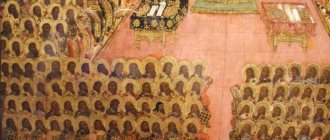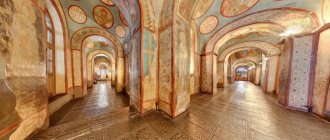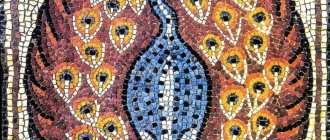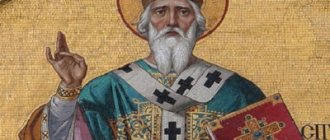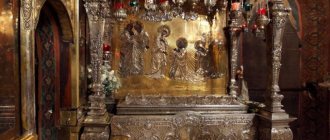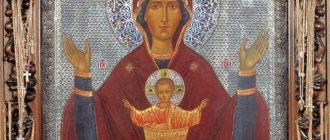History of the construction of Orthodox buildings
The sacred buildings of Christianity initially had the character of a shelter. They were housed in dungeons and various shelters. The catacombs were the burial place of the first Christian martyrs, whose bodies had to be hidden from the desecration of pagans and persecutors. It was the performance of secret services over the graves of the martyrs that began the tradition of serving the liturgy on Holy relics.
The catacombs were built in the form of a complex network of intertwining corridors and multi-tiered galleries connecting large halls for meals and meetings. With the legalization and freedom of professing Christianity, the catacombs lose their original meaning. Memorial basilicas began to be erected over their entrances, and burials began to take place near them.
The first temples began to be built in the 4th century under the Byzantine Emperor Constantine. They had the shape of an oblong 4-corner room with a small protruding entrance and a rounded apse in the altar part. These first Christian churches were called basilicas.
Sacred buildings of Christianity began to be built in the 4th century under the Byzantine Emperor Constantine.
The first domed church was the world-famous St. Sophia Cathedral of Constantinople, which surpassed in size all known domed buildings of ancient times. By the 9th century, the cross-domed type of the Byzantine temple had already formed with a characteristic subtle differentiation of vaults and spaces, which contributed to the symbolic understanding of the world of the particularity of the place.
In Christianity, the temple combines the earthly and heavenly spheres, and the dome and vaults serve as an association with the higher heavenly world. Later, other architectural types of church buildings appeared.
In the West, the Gothic style of cathedrals with high spiers became widespread. Russian church architecture took a lot from Byzantine construction, but added its own unique elements.
Kiev-Pechersk Lavra, Kyiv, UkraineKiev-Pechersk Lavra (Ukrainian: Kiev-Pechersk Lavra) is one of the first monasteries founded in Russia. Founded in 1051 under Yaroslav the Wise by monk Anthony, originally from Lyubech. The co-founder of the Pechersk Monastery was one of Anthony’s first students, Theodosius. Prince Svyatoslav II Yaroslavich gave the monastery a plateau above the caves, where beautiful stone churches decorated with paintings, cells, fortress towers and other buildings later grew. The names of the chronicler Nestor (author of “The Tale of Bygone Years”) and the artist Alypius are associated with the monastery...
Holy Dormition Pochaev Lavra, Pochaev, Ukraine
The Holy Dormition Pochaev Lavra (Ukrainian: Svyato-Uspenska Pochaivska Lavra) is an Orthodox monastery (lavra) in Pochaev (Ternopil region) in Ukraine. The largest Orthodox shrine in Western Ukraine and the second after the Kiev Pechersk Lavra. According to legend, the monastery was founded by monks of the Kiev Pechersk Lavra, who fled from the Tatar invasion in 1240. The first chronicle mention dates back to 1527...
Holy Dormition Svyatogorsk Lavra, Svyatogorsk, Ukraine
Svyatogorsk Dormition Lavra (Holy Dormition Svyatogorsk Lavra) is an Orthodox monastery of the Ukrainian Orthodox Church in Svyatogorsk (Donetsk region). Until 1918 - Svyatogorsk Assumption Hermitage, a non-staff, dormitory of the Kharkov diocese. Of the monks who labored in the monastery, 17 were glorified by the Ukrainian Orthodox Church as saints...
Zarvanytsia, Terebovlya district, Ternopil region, Ukraine
Zarvanytsia - Terebovlya district, Ternopil region, Ukraine (Ukrainian language)…
Alexander Nevsky Cathedral, Kamenets-Podolsky, Ukraine
Alexander Nevsky Cathedral is an Orthodox cathedral in the neo-Byzantine style, located in Kamenets-Podolsky. The temple was destroyed during the years of Soviet power and recently restored...
Alexander Nevsky Cathedral, Simferopol, Ukraine
Alexander Nevsky Cathedral is a cathedral in Simferopol, destroyed in the 1930s and now in the process of being reconstructed...
Armenian Cathedral, Lviv, Ukraine
The Armenian Cathedral of the Assumption of the Blessed Virgin Mary is a historical and cultural monument in Lviv (Ukraine). Located on the street. Armenian, 7-13…
Archangel Michael's Church, Krasnokutsk, Ukraine
Archangel Michael's Church is a functioning Orthodox church in the city of Krasnokutsk, Kharkov region, founded in 1880...
Cathedral of St. George, Lviv, Ukraine
The Archcathedral of St. George is the main Greek Catholic Cathedral of Lviv, the main shrine of the Ukrainian Greek Catholic Church. On its territory for a long time there was a residence of the metropolitans of the UGCC...
Admiralty Cathedral, Nikolaev, Ukraine
Admiralty Cathedral (Cathedral of St. Gregory of Great Armenia) is an Orthodox church that existed in Nikolaev from the 18th to the 20th centuries...
Holy Trinity Cathedral, Lutsk, Ukraine
Holy Trinity Cathedral (Ukrainian: Holy Trinity Cathedral) is the cathedral church of the Ukrainian Orthodox Church of the Kiev Patriarchate in Lutsk…
Dominican monastery and cathedral, Lviv, Ukraine
The Dominican Cathedral and Monastery is a religious building in Lviv (Ukraine), one of the most significant monuments of Baroque architecture in the city. In the 1990s, the cathedral was transferred to the UGCC and is called the Church of the Most Holy Eucharist...
Assumption Cathedral, Chernigov, Ukraine
Assumption Cathedral (Ukrainian: Assumption Cathedral) is the cathedral church of the Yelets Monastery in Chernigov. Its construction at the very beginning of the 12th century is associated with the name of the founder of the Olgovichi, the Chernigov prince Oleg Svyatoslavich. This monument has survived almost entirely to our time...
Kazan Church, Lugansk, Ukraine
Kazan Church is a historical Orthodox church in Lugansk (1864-1935)…
Cathedral of the Nativity of the Blessed Virgin Mary, Kirovograd, Ukraine
The Cathedral of the Nativity of the Blessed Virgin Mary is the cathedral of the Kirovograd and Novomirgorod diocese in Kirovograd, an architectural monument...
Latin Cathedral, Lviv, Ukraine
Latin Cathedral (Archicathedral Basilica of the Assumption of the Blessed Virgin Mary, Polish. Bazylika Archikatedralna pw. Wniebowziecia Najswietszej Marii Panny; Katedra Lacinska, Ukrainian. Archcathedral Basilica of the Assumption of the Blessed Virgin Mary; Latin Cathedral; Latin Cathedral) - Catholic Cathedral in Lviv (Ukraine). The Cathedral of the Lviv Archdiocese has the status of a “minor basilica”...
St. Nicholas Cathedral, Mariupol, Ukraine
St. Nicholas Cathedral is an Orthodox church in the Donetsk region...
Nicholas Cathedral, Novomirgorod, Ukraine
Nicholas Cathedral (Saint Nicholas Cathedral, St. Nicholas Cathedral) is a stone cathedral in Novomirgorod, an architectural monument of the 18th century, destroyed by Soviet power in 1932. It was located on the territory of a modern city park…
Intercession Cathedral, Okhtyrka, Ukraine
The Holy Intercession Cathedral is the main Orthodox church in the city of Akhtyrka, Sumy region, the former location of the Akhtyrka Icon of the Mother of God. Recognized as a historical and architectural monument of Ukraine of national significance...
Ascension Cathedral, Alexandrovsk, Ukraine
The Holy Ascension Cathedral is an Orthodox cathedral in Aleksandrovsk, built in 1791. The Holy Ascension Cathedral is one of the most ancient churches of the Lugansk diocese of the Ukrainian Orthodox Church...
Intercession Cathedral, Kharkov, Ukraine
The Cathedral of the Intercession of the Most Holy Theotokos is a parish Orthodox church in Kharkov, Kharkov diocese of the Ukrainian Orthodox Church, in the name of the Intercession of the Most Holy Theotokos...
Holy Assumption Cathedral, Poltava, Ukraine
The Holy Assumption Cathedral is the main temple on the territory of the Poltava Fortress. The cathedral took 22 years to build - from 1748 to 1770...
Resurrection Cathedral, Kyiv, Ukraine
The Cathedral of the Resurrection of Christ is a cathedral of the Ukrainian Orthodox Church (MP) under construction in Kiev...
Cathedral of the Resurrection of Christ, Ivano-Frankivsk, Ukraine
The Cathedral of the Resurrection of Christ (Ukrainian: Cathedral of the Holy Resurrection) is the cathedral of the Ivano-Frankivsk Archdiocese of the Ukrainian Greek Catholic Church in the city of Ivano-Frankivsk, in the Ivano-Frankivsk region of Ukraine...
Three-Anastasievsky Cathedral, Glukhov, Ukraine
Three-Anastasievsky Cathedral is the largest church in Glukhov, the cathedral of the Konotop and Glukhov diocese...
St. George's Cathedral, Kamenets-Podolsky, Ukraine
St. George's Cathedral is the cathedral of the Kamenets and Gorodok diocese of the UOC, an architectural monument of national significance...
Nicholas Cathedral, Lugansk, Ukraine
St. Nicholas Cathedral is an Orthodox cathedral in Lugansk, built in 1841 in honor of St. Nicholas the Wonderworker and destroyed in 1935, located on Nikolaevskaya Square of the city (now Red Square) ...
Lutheran Church, Odessa, Ukraine
St. Paul's Church in Odessa is the Lutheran Cathedral of St. Paul of the German Evangelical Lutheran Church of Ukraine, the religious center of Ukrainian Lutherans of the German church tradition - a historical building and architectural monument of national significance...
Peter and Paul Cathedral, Lugansk, Ukraine
Peter and Paul Cathedral is an Orthodox church in Kamenny Brod that has existed since 1761. The Peter and Paul Cathedral remained intact during the Bolshevik era...
St. Sophia Cathedral, Kyiv, Ukraine
Hagia Sophia (St. Sophia Cathedral) is a temple built in the first half of the 11th century in the center of Kiev, according to the chronicle, by Prince Yaroslav the Wise...
Vasilyevsky Church, Pesochin, Ukraine
Vasilyevsky Church is a functioning Orthodox church in the city of Pesochin, Kharkov region, founded in 1828...
St. Vladimir's Cathedral, Lugansk, Ukraine
St. Vladimir's Cathedral is an Orthodox cathedral in Lugansk, which is currently the largest religious building in southeastern Ukraine. The cathedral can accommodate about 3 thousand parishioners...
St. Vladimir's Cathedral, Kyiv, Ukraine
Vladimir Cathedral is the main temple of the Ukrainian Orthodox Church of the Kiev Patriarchate. Located in Kyiv on Taras Shevchenko Boulevard...
Vladimir Cathedral, Sevastopol, Ukraine
The Cathedral of St. Prince Vladimir Equal to the Apostles in Sevastopol is an Orthodox church, the burial place of Russian admirals and naval officers, an architectural and historical monument...
Spaso-Preobrazhensky Cathedral, Chernigov, Ukraine
Spaso-Preobrazhensky Cathedral is a five-domed, eight-pillar church in Chernigov. The oldest surviving monument of architecture of the Kyiv state...
Spaso-Preobrazhensky Cathedral, Dnepropetrovsk, Ukraine
Spaso-Preobrazhensky Cathedral of Dnepropetrovsk is one of the cathedral churches of the Dnepropetrovsk diocese (formerly Ekaterinoslav) of the Ukrainian Orthodox Church, consecrated in honor of the Transfiguration of the Lord...
Holy Transfiguration Cathedral, Donetsk, Ukraine
The Holy Transfiguration Cathedral is a cathedral Orthodox church in Donetsk in honor of the Transfiguration of the Lord, the main temple of the Donetsk and Mariupol diocese of the Ukrainian Orthodox Church...
Transfiguration Cathedral, Izium, Ukraine
Spaso-Preobrazhensky Cathedral is an Orthodox church in the city of Izyum, Kharkov region. Built during the founding of the city (construction of the Izyum fortress) in the early 1680s...
Spaso-Preobrazhensky Cathedral, Odessa, Ukraine
Odessa Spaso-Preobrazhensky Cathedral is the largest Orthodox church in Odessa; founded (the original building) in 1794, consecrated in 1808, destroyed in 1936. Recreated in the same place in the early 2000s...
Trinity Cathedral, Chernigov, Ukraine
Holy Trinity Cathedral in Chernigov is the cathedral of the Chernigov diocese of the Ukrainian Orthodox Church. Previously, it was part of the complex of the Trinity-Ilyinsky Monastery...
Holy Trinity Cathedral, Lugansk, Ukraine
Holy Trinity Cathedral is the cathedral of the Ukrainian Orthodox Church of the Kiev Patriarchate in the city of Lugansk...
Trinity Cathedral, Sumy, Ukraine
Trinity Cathedral is an Orthodox church in the city of Sumy, Ukraine. A monument of neoclassical architecture of the early 20th century. The foundation stone for the cathedral, designed by local architect Karl Scholz, took place on May 6, 1901. Construction of the temple continued intermittently until 1915...
Ascension Cathedral, Izium, Ukraine
Ascension Cathedral is an Orthodox cathedral in Izium, Kharkov region, built in 1826. It is the cathedral of the Izyum and Kupyansk diocese of the Ukrainian Orthodox Church...
Cathedral of St. Alexander Nevsky, Yalta, Ukraine
The Cathedral of the Holy Blessed Prince Alexander Nevsky is the main Orthodox cathedral of Yalta, one of the city’s attractions...
Church of the Ascension, Zolochiv, Ukraine
Holy Ascension Church is an Orthodox church in Zolochiv. The church belongs to the Ukrainian Orthodox Church of the Moscow Patriarchate...
Features of Christian buildings
The temple building was originally different from other buildings. It was built as a house of God for performing a special ritual of worship.
The sacred buildings of Christianity were always crowned with a vaulted dome, symbolizing the sky, which created a special contemplative and sublime mood for those participating in the service. The completion of the dome is the cross, as a statement and symbol of the head of the church of Jesus Christ.
A special feature of the design of the Russian dome was its shape, reminiscent of the flame of a burning candle.
In its historically established form, the Christian temple personifies the Kingdom of God, which has come in power.
From this comes the 3-part division of the temple:
- The altar represents the hidden Divine realm of existence.
- The temple in its main part marks the spiritual sky, the upper world, the area of angelic service.
- The porch or meal represents earthly life.
Stone tented churches
The forms of wooden temples influenced stone (brick) construction.
They began to build intricate stone tented churches that resembled huge towers (pillars). The highest achievement of stone hipped architecture is rightfully considered the Intercession Cathedral in Moscow, better known as St. Basil's Cathedral, a complex, intricate, multi-decorated structure of the 16th century.
The basic plan of the cathedral is cruciform. The cross consists of four main churches located around the middle one, the fifth. The middle church is square, the four side ones are octagonal. The cathedral has nine temples in the form of cone-shaped pillars, together making up one huge colorful tent.
Tents in Russian architecture did not last long: in the middle of the 17th century. Church authorities prohibited the construction of tented churches, since they were sharply different from the traditional one-domed and five-domed rectangular (ship) churches.
Tent architecture of the 16th-17th centuries, which draws its origins from traditional Russian wooden architecture, is a unique direction of Russian architecture, which has no analogues in the art of other countries and peoples.
Stone tented Church of the Resurrection of Christ in the village of Gorodnya.
St Basil's Church
Church of the Intercession in Fili. The first stone tented temple
Temple "Quench My Sorrows" Saratov
Church of the Ascension in Kolomenskoye
Stone tented Church of the Resurrection of Christ in the village of Gorodnya.
St Basil's Church
Church of the Intercession in Fili. The first stone tented temple
Temple "Quench My Sorrows" Saratov
Church of the Ascension in Kolomenskoye
Symbolism
The sacred buildings of Christianity have their own special symbolism hidden from the uninitiated eye. Many symbols originated in the early era of Christianity, during a period of terrible persecution, and carried the meaning of recognizing initiates.
Symbolism:
- The round dome symbolizes eternity, peace, constancy and peace in God, the overcoming and victory of spirituality over dead matter.
- Pigeon is a symbolic image of the Holy Spirit, as well as a sign of peace and spirituality of the Christian soul.
- The Lamb became a symbol of the sacrificial love of the Holy Trinity and its 2nd person, the Lord Jesus Christ.
- The lion symbolizes power and strength.
- The olive branch has become a symbol of victory and the triumph of eternal peace.
- The lily is considered the flower of the Virgin Mary and the Annunciation, symbolizing purity.
- The vines and bread recall the Eucharistic communion of faithful Christians.
- The ship depicts human life and the Church as a society, overwhelmed by the passions and unrest of the surrounding sea of life.
- The anchor symbolizes firmness and support.
- The lyre became the image of the Gospel teaching, delighting the soul.
Construction of a Catholic church
Main article: Catholic temple
- Narthex
- Main nave (naos)
- Side naves - 2 for a 3-nave temple, 4 - for a 5-nave temple, etc. In Spain - es: Lado de la Epístola y lado del Evangelio (Nave of the Message - right; Nave of Scripture - left - according to the arrangement of the holy books) .
- Towers (bell towers) - optional
- Side chapel
- Transept (middle cross, dome space)
- Transept arms, transverse nave
- Apse with altar
- Crown of chapels
- Choir - not always, usually a bypass gallery
- Dispensary
Structure of a Catholic Church (Image Map)
CATHEDRAL OF SAINTS PETER AND MARY (COLOGNE CATHEDRAL)
Where: Cologne, Germany
Photo: pixabay.com
Built over six centuries (!), Cologne Cathedral, dedicated to Saints Peter and Mary, is included in all ratings of the largest beautiful and grandiose churches not only in Europe, but throughout the Christian world. It literally soars 157 meters above the very center of Cologne, dominating the Rhine Valley skyline for miles. Although Cologne Cathedral is not the tallest in the world (Ulm Cathedral is 4 meters taller), it remains the number 1 temple in the world in terms of façade width (61 m) and the largest Gothic cathedral in all of Germany.
It is also the most visited attraction in all of Germany: about 20,000 tourists and guests of Cologne come here every day to look at the majestic Gothic facades, buttresses and sculptures, and, of course, to go inside to admire the stained glass windows.
Features: Ranks third on the list of tallest churches in the world and is listed as a UNESCO World Heritage Site. The cathedral is also known throughout the Christian world for the fact that revered relics are kept here, the main one of which is the relics of the Three Wise Men, the very same ones who brought gifts to the Child Christ at Christmas. They lie in the golden “Lar of the Three Magi”.
Wang Church in Karpacz
Where: Karpacz, Poland
Photo: pixabay.com
“A Scandinavian emigrant in the Polish countryside” - this is exactly what one could call this most visited wooden church in the world. It was built in Norway - entirely from wood, without a single nail - and then transported to Poland in 1842, when it was given to local Protestants by the Prussian King Frederick, who took pity on the church, which was about to be demolished.
The beginning of construction of the church dates back to the 12th century; itself it is one of the few remaining examples of the old school of church building architecture, which was especially popular in the Nordic countries at the time. Today this attraction can be found among the green hills and spruce forests of the Krkonose Mountains.
Features: Vang Church is visited by more than 2,000 tourists every year. The original Viking Age inscriptions and runes are still visible on the walls of the church. The church was originally purchased by the king for the Berlin museum, but in 1844 the king donated it to the Polish Protestant church at the request of Countess von Rehden from Bukovets.
MARIAC'S CHURCH (CATHEDRAL OF THE ASSUMPTION OF THE HOLY VIRGIN MARY)
Where: Krakow, Poland
Photo: commons.wikimedia.org
This temple acquired its modern appearance as a result of reconstruction in 1392-1397, although the first stone church in the Romanesque style on this site was built at the beginning of the 13th century. Now this beautiful Catholic church faces the Krakow Main Market with its main façade.
An interesting feature of this church is the two completely different towers at the base: they have different heights and architectural elements. The spire of the upper tower is crowned with a gilded crown, and the lower one serves as a bell tower. Another “trick” of the church: during sunset, when the sun sets over the noisy main square, the entire cathedral seems to begin to glow red from the inside.
Interesting facts: On the high (82 m) Hejnalica Tower there is an hour bell with a diameter of 165 cm, cast in 1530. From here, every hour, the Mariacki Hejnal is heard, broadcast by Polish radio throughout the country as a signal of the exact time, and which is the “audio calling card” of Krakow and the whole of Poland. The temple has two parts and two entrances - for parishioners (from the square) and for tourists (on the side of the main one).
Kirch
Main article: Kircha
Lutheran church buildings in Russian are also called churches
[3], from German.
Kirche is a church (in all senses, both a community and a building, and of any Christian denomination), which is akin to the Dutch kerk
, Scottish
kirk
, English
church
and Russian
church
, ultimately going back to the Greek "κυριακή" ('Lord's').
kirchspiel was also used to designate the parish
(German: Kirchspiel).
Traditionally, there are three main types of building: cathedral
,
church
and
chapel (chapel)
.
A cathedral is usually the name given to the imposing church building that houses the bishop's see (in the episcopal system of church polity). The building where this pulpit was once located can also be called a cathedral. The church is the main type of parish building. A chapel as a separate building is usually built for special needs (for example, in cemeteries for funeral ceremonies). There are no liturgical differences between buildings - any sacraments, rites or ceremonies can be performed both in the cathedral and in the chapel, as well as in a residential building or in the open air. Lutheran Church in the Romanian city of Brasov
Notes
- p.128 “belonging to the Lord, the Lord’s”; Slavic languages were borrowed through Germanic languages (Church: Vasmer's Etymological Dictionary).
- Christian Temple // Encyclopedic Dictionary of Brockhaus and Efron: in 86 volumes (82 volumes and 4 additional). - St. Petersburg, 1890-1907.
- Pickaxe in Ushakov's dictionary
- Church // Explanatory dictionary of the Russian language: in 4 volumes / chapter. ed. B. M. Volin, D. N. Ushakov (vol. 2-4); comp. G. O. Vinokur, B. A. Larin, S. I. Ozhegov, B. V. Tomashevsky, D. N. Ushakov; edited by D. N. Ushakova. - M.: State Institute "Soviet Encyclopedia" (vol. 1): OGIZ (vol. 1): State Publishing House of Foreign and National Dictionaries (vol. 2-4), 1935-1940.
- Cathedral Archived copy from April 11, 2015 on the Wayback Machine (inaccessible link from 06/14/2016 [2085 days]) // Russian Humanitarian Encyclopedic Dictionary: In 3 volumes - M.: Humanit. ed. VLADOS center: Philol. fak. St. Petersburg state University, 2002.
- Complete Orthodox Theological Encyclopedic Dictionary, vol. 2. M.: Vozrozhdenie, 1992
- The biggest, longest, tallest…
- GUINNESS BOOK OF RECORDS WORLDS LARGEST CHURCH BUILDING
- World's largest temple completed in Lagos (link unavailable since 02/07/2018 [1482 days])
- Taylor Berglund.
World's Largest Church Auditorium Dedicated in Nigeria. Charisma News. Date accessed: December 23, 2022. - Franklin Graham Preaches to 12,000 in Mainland China. Retrieved November 7, 2022.
- Luis Palau Association.
Luis Palau Back in China to Meet with Officials, 14,000 Hear the Evangelist and Rev. James Meeks (English). www.prnewswire.com. Date accessed: November 7, 2022.
How are churches structured and why do they face the altar to the east?
Jan Laken. Installation of the Tabernacle of Meeting (detail). Second half of the 17th century – beginning of the 18th century. State Museum of Fine Arts named after A.S. Pushkin, Moscow
Unknown artist. Tabernacle (fragment). XIX century. Image: wikipedia.org
Jan Laken. Tabernacle (fragment). Second half of the 17th century – beginning of the 18th century. State Museum of Fine Arts named after A.S. Pushkin, Moscow
The prototype of the Orthodox church was the Old Testament tabernacle. According to legend, the Lord ordered Moses to build this camp tent in order to place the Ark of the Covenant there during his stays. The tabernacle consisted of a large courtyard where the people prayed, and an elongated room, which was divided by a curtain into the sanctuary and the holy of holies. Only the priests entered the sanctuary, where they burned fragrant resin - incense - on the altar in the morning and evening. The Holy of Holies symbolized the Heavenly, God's kingdom and was the most sacred place where the Ark of the Covenant was kept. Only the high priest could enter there - and only once a year. The Temple of Solomon, which, according to the Old Testament scriptures, was the house of God on earth, had the same structure.
In an Orthodox church, the courtyard corresponds to a small extension in front of the entrance - the narthex. He personifies the not yet renewed, sinful world. In the first centuries of Christianity, during services there stood believers who were temporarily excommunicated from the Church due to grave sins, and those who were just preparing to be baptized.
The sanctuary replaces the middle part of the temple - the nave. But, according to the New Testament, now the Kingdom of God is open to everyone, so all Christian believers pray here. But only priests can enter the altar, which replaced the Holy of Holies. It is believed that the main event of the service takes place there - the bread and wine become the body and blood of Jesus Christ. The three-part composition of the Orthodox church develops from west to east, towards Jerusalem. It is there, according to legend, that Christ should appear again. And the temple is a prototype of the path that a Christian must go through in order to unite with God.
From the outside, the altar part is usually covered by three semicircular extensions - apses. On the opposite side there is a portal - the main entrance to the temple, and the porch in front of it is called the porch. One or more drums rise above the temple. These are towers with windows through which light enters the temple. They end with helmet-shaped or bulbous chapters and are crowned with crosses.
Cathedral of St. David/St. David's Cathedral
Where: St David's, Wales
Photo: pixabay.com
Situated on the very tip of West Wales, St David's Cathedral looks out over the rough seas of Ramsey Island and St Bride's Bay. Since its founding in the 7th century, it has been subject to repeated Viking attacks, been under the patronage of William the Conqueror and received special privileges from Pope Calixtus II: two pilgrimages to St. David's were equivalent to a pilgrimage to Rome.
Today, the cathedral amazes tourists with its variety of Gothic and medieval styles and the atmosphere of legends and myths that can be expected from a 1300-year-old building.
Features: The cathedral is dedicated to the national patron saint of Wales - St. David.
House of Prayer
Main article: House of Prayer
House of Prayer is the name of a place of worship (church) among Evangelical Christians (Baptists, Pentecostals), Seventh-day Adventists and some other Protestant denominations in Russia. In the house of prayer, believers hold various services and meetings, including the main Sunday (or Saturday) services and weddings of church members.
A house of prayer usually has: a hall for worship, a library and a room for meetings of church ministers. Also in the house of prayer there may be (depending on the need, the wishes of the church and the size of the building): a baptistery, a room for Sunday (Saturday) school classes, rooms for classes and meetings of various groups of parishioners, a dining room and kitchen, a Christian literature store, premises for rent Christian missions and organizations, etc.
CATHEDRAL OF THE HOLY FAMILY (SAGRADA FAMILIA)
Where: Barcelona, Spain
Photo: pixabay.com
The most famous "unfinished construction" in the world - the Sagrada Familia in Barcelona, known as the Sagrada Familia, is known to tourists better than any other building in Barcelona. Even though this is still an unfinished building to this day.
The famous project of Antoni Gaudi soars more than 160 meters above the plains of the Costa Brava. It presents such a symphony of architectural styles that visitors to this colossal interior can spend several hours examining every detail. It is precisely because of its unusual appearance that it has become one of the main attractions of Barcelona.
Gloomy gargoyles lurk in the secluded corners of the cathedral, while huge turtles in their shells cling to the steles. The interior is dominated by a multi-colored “hodgepodge” of towering tree-like columns. Art Nouveau, Gothic, surrealism, Romanesque architecture - the Sagrada Familia has it all.
Interesting facts: According to the Spanish government, the temple will be completely completed no earlier than 2026.

